Structure of Society & its Reform (1000-1215)
1/26
Earn XP
Description and Tags
add stuff in about knights & blurring boundaries - increasing anxiety ab. it + other ways church consolidates its power & end result - ignore 1st 6 FCs
Name | Mastery | Learn | Test | Matching | Spaced |
|---|
No study sessions yet.
27 Terms
The Right Ordering of Society: Community
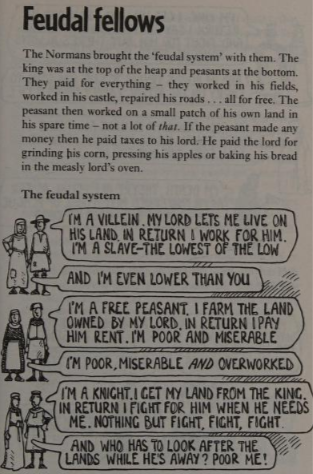
Types 🧍 = 3 ‘orders’
Why focus on types, individuals?
Indiv. 🧍hood ↓ thing - 🧍 feel into broad categories accord. to their 🩸 & lineage
∵🧍 consid. largely as equal only in theological sense. In terms of their bodies & existences, NOT equal
souls equal BUT
bodies (flesh &🩸)Individualityuntil 18thC liberalism
Georges Duby split medieval soc. into 3 groups depending on job do for soc…
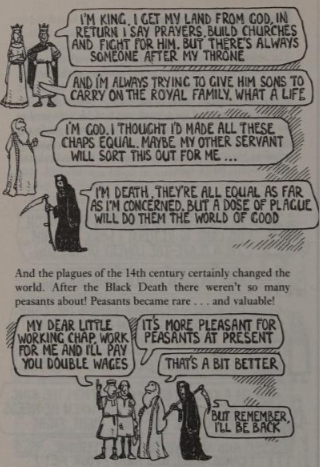
Types 🧍 = 3 ‘orders’
those who work (laboratories)
Peasants broadly fell into 2 categories…
Free (serfs)
legally tied to lord’s 🟩
balance pay ↑ heavily service-based; for free, often 💰/ produce based
legally owned by their lords →
permitted to leavestatus transmitted by 🩸
Extorted…
tallages = arbitrary payments to supp. military/ political activity
merchet = fine payable to marry off daughters (∵ lord’s property)
leywrite = fine for extra marital sex
heriot = fine to ‘inherit’ 🟩
all 🟩 reverts to its rightful owner (lord) on 😵, unless successors could make lord favourably disposed to them by means payment heriot
after 😵, lord took his possessions (had only been ‘loaned’ to peasant dur. his lifetime)
mill privileges - ‘you HAVE to use MY mill, & it’s expensive’
could use own grain but use lord’s mill, which came @ extraction proportion grain → Lord & miller
→ had wealth/ 🍔/ produce extracted ← them by their social betters @ every turn
Free (freemen)
hold 🟩 tenure by virtue agreem.
normally held by combin. service & rents in kind/💰
permitted to leave BUT restricted by economic/ 👪 ties ∴
freein sense can just leavestatus transmitted by 🩸
Rosy for them either…
Also had to pay mill privileges (pay w/💰/ produce as rent,
service) → could be cripplingLords might be will. to let them use any 🟩 @ all → labourers, sell. their lab. w/o tenure agriculture 🟩.
(econ. prosperity) fact ould sell their services → do well,
likeserfs(poor harvest) 1st to starve;
have 🟩 to supp. themselves→ even though legally free, v/
sec.existence
In practice, hard to disting. bet. 2…
all held & lived on 🟩
all obliged to pay rent
all had wealth/ 🍔/ produce extracted ← them by their social betters @ every turn
flexibility status: some free peasants as labourers + (econ. prosperity + lords needed 💰 so willing to sell right to their own serfs) serfs could gather tog. en. resources to pay for their freedom/ manumission
How did 🟩 ownership work + origins in 🟩 system?
What did feudal system look like?
origins in 🟩 system
All 🟩 theoretically 👑’s: holding it to be able to use it for a period is called ‘tenure’ (own outright)
Tenure granted in exchange for service - in war/ court service, or for lab.
🫅 granted tenure 🟩 to political/ military allies in exchange for assitance.
Such allies (knights) did homage: help 🫅 in his 🕑 need & publically acknowl. his superiority.
Knights able to look after it (e.g. if @ war) → vassals → huge chain where 🧍 exchanging homage up ⚖, protection & security down ⚖ (e.g. vassal owes homage up ⚖) .
messy
🟩 grant
service
🧍 held 🟩s ← multiple🧍→ conflicting loyalties
(e.g. Brittany) might own 🟩s ← both English & French lords
some knights owned land they had not done service for
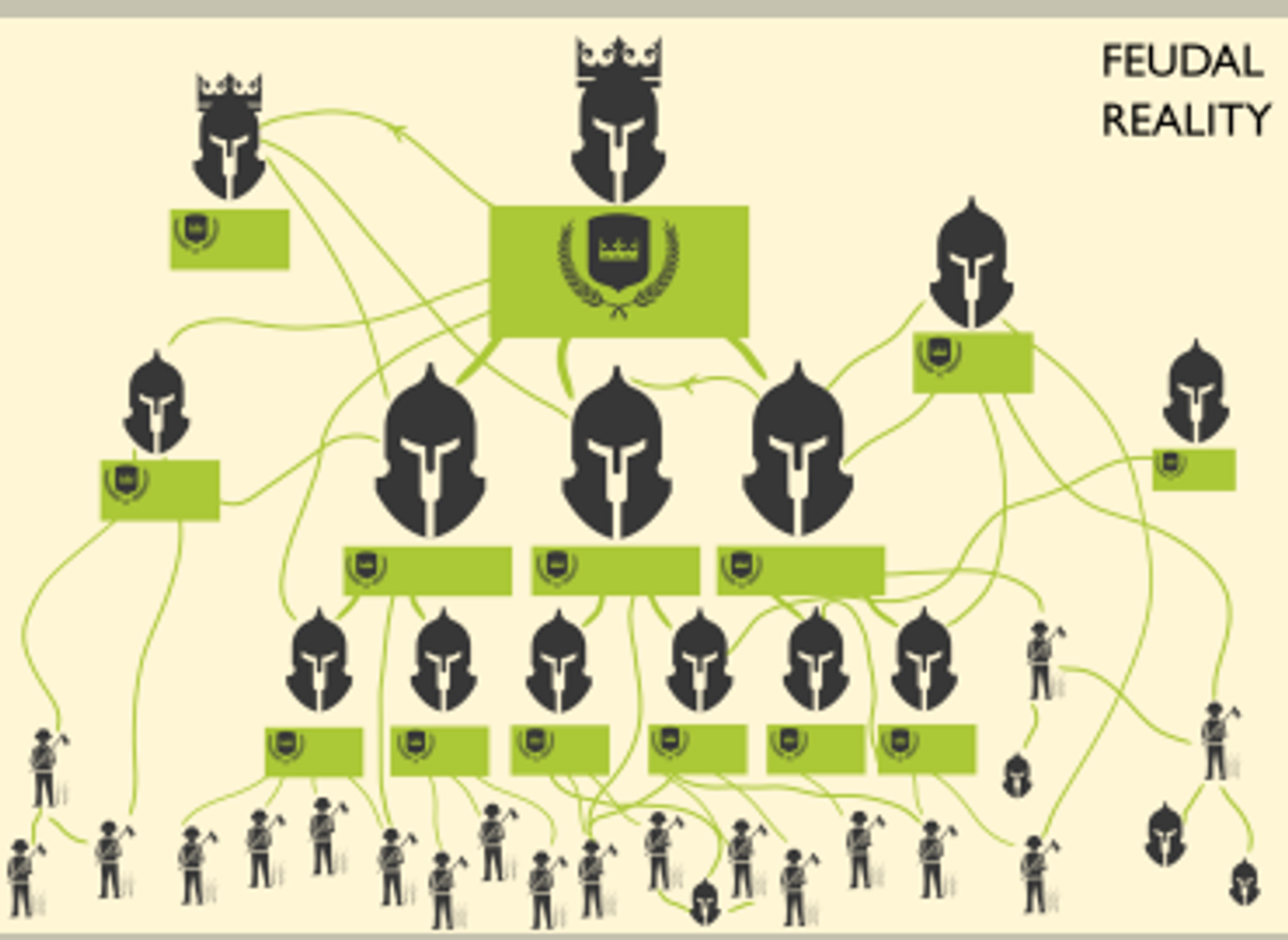
problem w/us. term ‘feudalism’
Karl Marx advocated that feudalism = discreet, neat stage people moved on ← once discovered money
whilst was transition to capitalism (A-Level Notes), was flexibility
People most shaped by kinship networks (relations to kin & community) - of utmost social-political importance
one legally, socially, reputationally reliant on who you know & who will back you (see feud notes + kings in intro lecture)
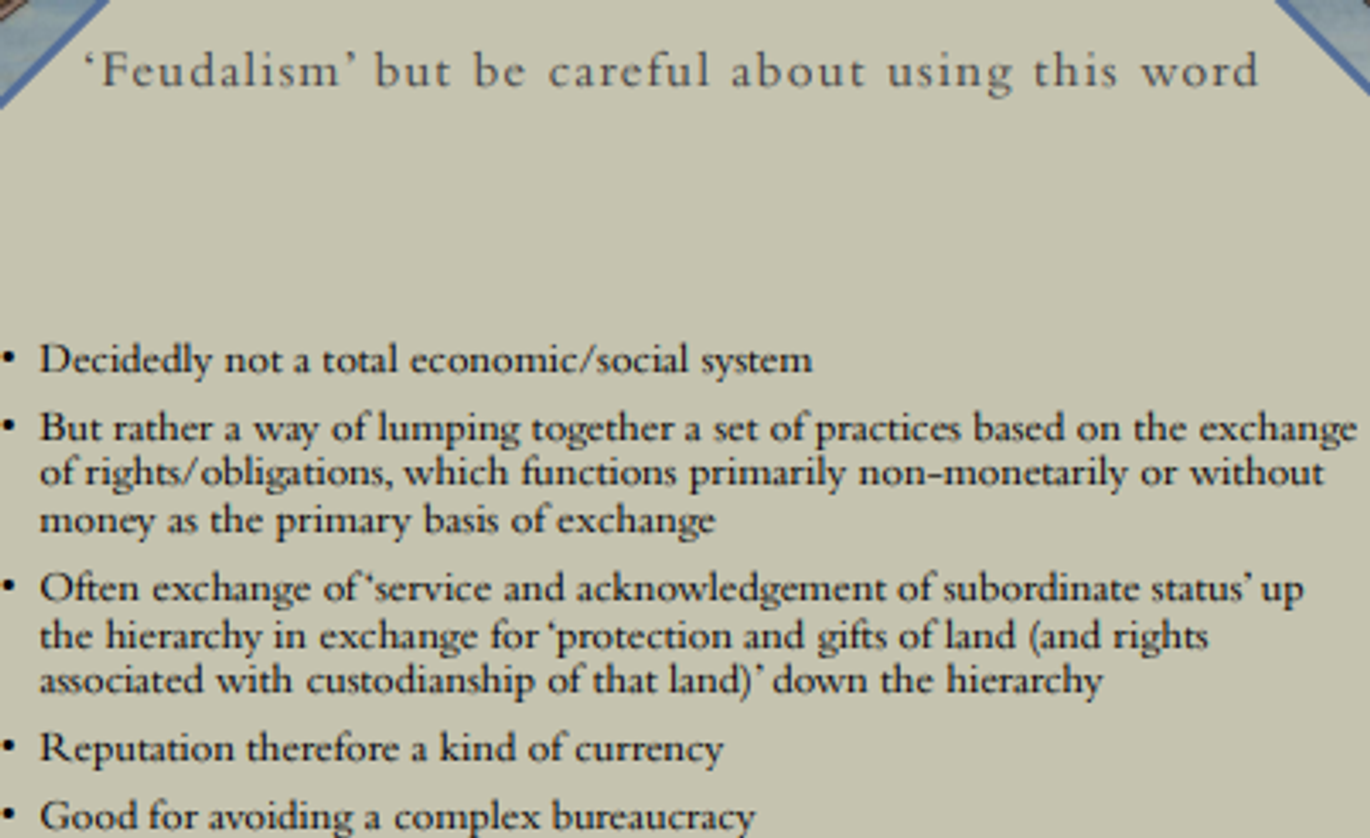
Types 🧍 = 3 ‘orders’
Those who fight (bellatores)
Basic econ. rel. w/peasants = 1 of extortion (protection 💰)
Viol. depended on region, context & personality (e.g. Thomas of Marle)
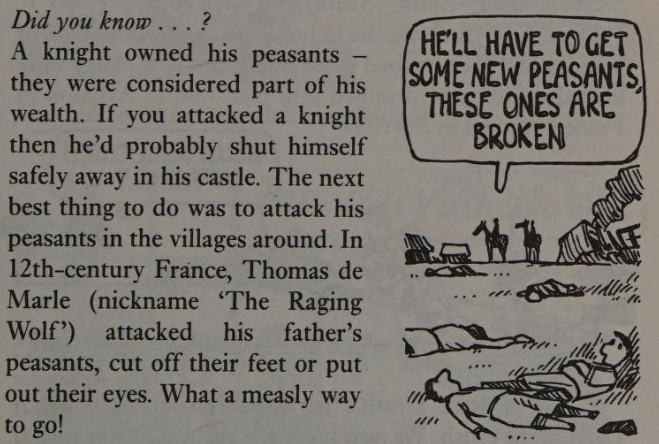
The Right Ordering of Society: the Papacy & the Reform Movement
1 most common misconceptions EMA ⛪’s power
impact this on pop. perception MA
Post-MA tendency (cf. Reformation, Locke, ⛪-👾 dualism) focus dominance ‘⛪’ - governed every aspect daily & spiritual life.
Refers to RCC, its head (pope in Rome) & representatives (archbishops, bishops & priests) maintaining form centralised ecclesiastical power across villages, towns & cities W/Europe.
→ received version MA in which everyone adhered fully to ✝ beliefs; 🕑 when
dep.thought stifled by all-pervading ⛪
period characterised by atmosphere fear, superstition & gen. ignorance
primary source showing this true
(1218, William Auxerre) Text, Summa Aurea
(demean. generalisation) Simpletons led like dumb 🐱s by ⛪
Often quotes to disting. bet. intellectuals & ‘simpletons’ in medieval religion.
The oxen are the preachers or prelates… the she-asses are said to be simple people, who ought to rely on what is said by their elders. The sense therefore is that the prelates should instruct the simple, & the simple ought to rely on their faith… To believe implicitly is to believe that the church teaches is true (R12, Femina)
division bet. think. ‘oxen’ & simple ‘she-asses’ rooted Bible
ignorance 🔗 femininity rooted misogyny
How much direct power did ⛪ actually have?
appearances auth. but little tangible power to express it - they have power but only if people take it seriously
appearance auth. - actually had v/little power
Why did ⛪ have so little direct power?
Mostly isol. in Rome/ Avignon - little finances & limited military capabilities.
Could bear arms on relig. grounds
Divided (explained later)
‘⛪’ consisted many diff. parts (bishops, monastic orders, papacy, cardinals, legates) - alw.
agreed
Some Rome even off-limits to partic. popes throughout C11 → able to insitll auth. over Rome, let alone all Europe
(1st ½ C10) system parish ⛪s & supervision ordin. ✝s
Europe uniformly committed to ✝
Most West would’ve consid. themselves to be what we think of today as RC.
Rhythm life in cities, towns & villages would’ve been punctuated by routine festivals @ local ⛪.
BUT levels devotion & adherence varied dep. community.
Despite papacy’s emphasis on its intrinsic, God-given authority via Apostolic Succession, lacked direct power to enforce its will.
How did ⛪ derive power?
What did this tenuous auth. hinge on maintaining?
Instead, reliant on secular (to do fighting for them) & ecclesiastical allies (heads monastic institutions…) to carry out its mandates, which in turn relied upon public acceptance & recogn. papacy’s auth. to command others to its will.
Power papacy dependent on what🧍thought papacy had power to do,
what it actually could do.
What did this tenuous auth. hinge on maintaining?
Good rep. convinced lay🧍 its legitimacy - holin. had to be obviously be there.
How did papacy express its power / what form did papacy’s power take?
(early C11) Papacy had power to do v/little but write a lot → expressed power through authoritative documents
Papacy’s power = ‘power to loose & bind’ - to make🧍follow agreements/ release ← obligation of so doing.
David D’Avray’s 🖼 ‘helpdesk’: bulls, legates, excommunication
🧍w/problems wrote to papacy to get their opinion - would reply🧍what most doctrinal thing was in elaborate papal bulls via legates (to impress & persuade)
could only react to what asked to judge on
Remained _ despite fact Rome for most period had biggest ⛪ ✝ Europe (St Peter’s Basilica) - many grand buildings we assoc. w/papal power yet
Reactive institution? Rarely proactive, except in shap. its attit. tow. responses.
concerns over secular influence on the church facilitated a Gregorian revival of the ancient ascetic tradition which included celibacy
rise of the Gregorian movement and its determination to mitigate secular influence on the papacy.
anxieties ab. boundary bet. secular & relig.
Celibacy became so important to the central medieval papacy due to the rise of the Gregorian movement and its determination to mitigate secular influence on the papacy.
rise Gregorian movem.
What were the 2 main concerns over secular corruption ecclesiastical?
dependency secular → destruction boundary bet. secular & relig. realms
RCC been corrupted by priests developed sec. lens in ecclesiastical matters → hold moral high ground
concern over secular influence in investiture (pull. strings)
conduct priests
→ Rome lawless city & popes little consequence: weak papacy relied on appearance auth.
But the follow. were threat to RCC’s holy rep. ∴ auth.
call for purity when these boundaries being eroded
rise Gregorian movem.
concern over conduct priests
simony
(lay patrons) buying & selling ⛪ offices
after Simon Magi in Bible
backdrop: service agreements → money C11 (capitalism) A-Level notes
This & fact often appointed family members into key roles → corruption
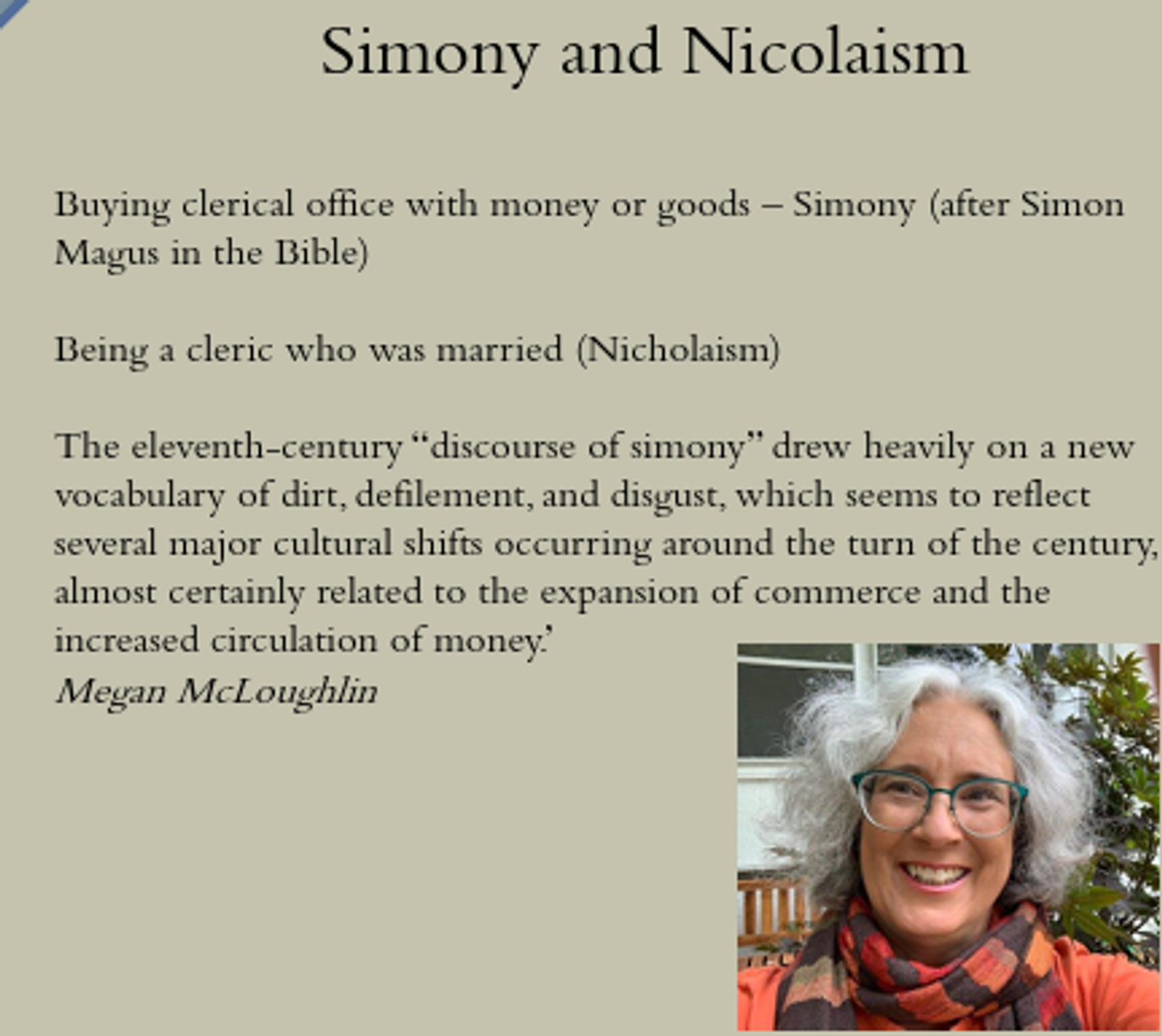
rise Gregorian movem.
concern over conduct priests
saeculim obsrurum/ pornocracy
period C10 where popes typically Roman aristocrats took mistresses, esp. Counts of Tusculum
local communities Rome got to elect Pope → chose their sons (of influential families)
Counts of Tusculum dominated papacy C10-12 (5/76) - (notoriously corrupt
ironically known by medieval contemporaries as Seculum Obscure (the dark ages)
pornocracy: (the rule of whores)
alleged partic. popes beholden to their mistresses & were allowing themselves to be ruled effectively by local women
primary source encapsulates critic. simony
The Epistola Widonis, or ‘ Letter of Guido ’, is a key source for the simony debates of the eleventh century, since it is usually considered the first major text to cast doubt on the validity of simoniacal ordinations.
about simoniac priest - not real priest
any priest elected through his use power/money not really a priest
through this kind of discourse, clergy setting themselves up for massive clash w/secular power
manifests in issue investiture
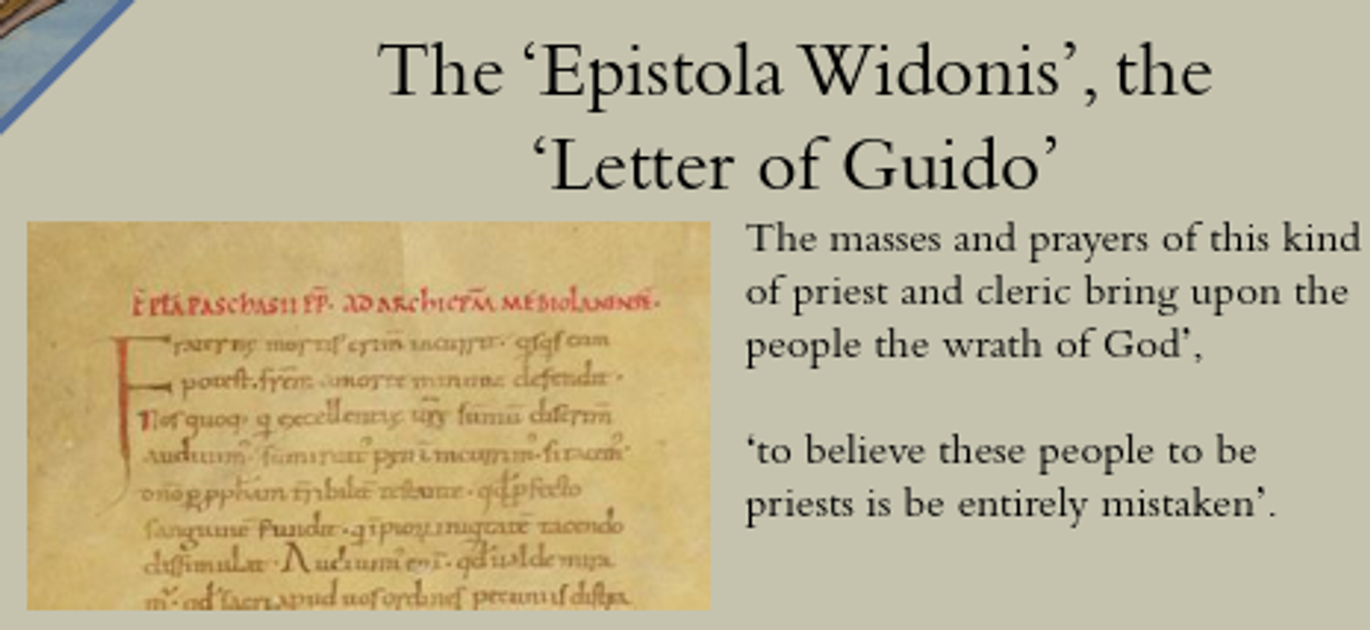
rise Gregorian movem.
concern over secular influence on investiture
Historically, bishops & abbots held considerable political power & controlled vast estates & resources, mak. their appointment a matter of great significance for both secular & ecclesiastical authorities.
Secular rulers sought to appoint bishops & abbots loyal to them ∵ these positions wielded signif. political power & control over land & resources.
→ Whilst bishops (by canons) & abbots (solely by their monks) theoretically elected dep., outside pressures prevailed (esp. in Rhineland, England)
Both kings & popes had say in who was elected bishops…
Popes:
Papal pallium = cloak (top layer bishop's garments) which symbolises auth. & responsibility papal office.
Conferred on bishops in special ceremony, symbol. their unity w/Pope & their auth. within their own dioceses.
Signifies bishop’s power to judge those under his leadership within RCC.
Kings/ emperors
Trad. asserted their right to appoint bishops & abbots, practice known as ‘lay investiture’.
Often confirmed bishops in lands they had jurisdiction over.
If a cathedral owned a particular set of land, the ownership of that land technically belonged to the king.
King would only confirm the ownership of that land when he approved of the bishop who held it.
Gave secular rulers consid. influence over RCC, allow. them to appoint individuals loyal to them & ensure. political stability within their realms.
bribery / intimid. cathedral canons to vote for candidate
(C11-12) Struggle for control over appointm. bishops & abbots betw. secular rulers (kings and emperors) & papacy, as RCC sought to assert its auth. over ecclesiastical matters, inlud. appointm. bishops & abbots.
Roman nobility & imperial factions often supported diff. candidates for the papacy → divisions within RCC.
→ weak papacy
rise Gregorian movem.
case study: Otto I Germany deposed John XII
Background:
Pope John XII faced accusations corruption, includ. simony, adultery & even alleged partic. orgies.
Emperor Otto I's Intervention:
(963) Emperor Otto I HRE convened a synod in Rome to address the allegations, asserting his influence.
Rode to Rome w/army to ensure synod's proceedings & to exert his influence over papal selection process.
Synod found John guilty these charged & deposed him ← papacy.
Otto I then installed Leo VIII as new pope in John's place.
Worsened by fact…
John
had beenin Rome @ time but instead out hunting wild boar in countryside (not sort of thing you should be doing if you were pope) - then killed later by husband of his mistress lol - corrupt papacy C10
Significance:
The Rome Synod of 963 and the deposition of Pope John XII by Emperor Otto I exemplify the complex relationship between the papacy and secular rulers during the medieval period.
It underscores the political power and influence wielded by secular rulers like Emperor Otto I over papal affairs, as well as the role of ecclesiastical councils and synods in addressing allegations of misconduct within the Church.
Overall, the deposition of Pope John XII in 963 represents a significant event in medieval papal history, reflecting the interplay of political, religious, and moral factors within the Church and broader society.
rise Gregorian movem.
case study: 1046 disputes over papal auth.
Disputes over who rightful pope was. Various factions claimed to be legit. pope, each vying for power & influence within RCC.
Did so by trying to position themselves as most reformist figures within RCC.
Likely sought to implement changes & reforms to address perceived issues such as corruption, abuse power & theological
agreements.
But were ultim. removed by Emperor Henry III for being too radical in their reforms (intervened in these disputes).
How?
Emperor Henry III's intervention in removing claimants to the papacy in 1046 likely involved a combination of political maneuvering, coercion, and possibly military force.
1. Political Influence: As the Holy Roman Emperor, Henry III held significant political power within the Holy Roman Empire and had influence over the affairs of the Church within his realm. He could exert pressure on bishops, clergy, and other influential figures to support his chosen candidate for the papacy.
2. Imperial Decree: Henry III could issue imperial decrees or edicts asserting his authority over matters within the Church, including the selection and appointment of popes. By declaring certain claimants to the papacy illegitimate or unfit for the office, he could undermine their credibility and support.
3. Military Support: In some cases, Henry III might have used military force or the threat of force to enforce his decisions and suppress opposition to his chosen candidate for the papacy. This could involve deploying imperial troops to occupy key territories or strongholds controlled by rival factions.
4. Diplomatic Pressure: Henry III could employ diplomatic channels to isolate and weaken rival claimants to the papacy. By forging alliances with other powerful figures or states within Europe, he could garner support for his preferred candidate while marginalizing his rivals.
Overall, Henry III's removal of claimants to the papacy likely involved a combination of political influence, imperial authority, and, if necessary, military intervention to ensure the ascension of a pope who was aligned with his interests and agenda.
Signif.
🎭s Henry III sought to maintain control over RCC
👓 these reformist movements as threat to his own auth./stability within empire.
🎭 power struggles and complexities within the medieval Church, where various factions competed for influence, both within the Church itself and in relation to secular authorities like Emperor Henry III.
rise Gregorian movem.
What actually happened in this ‘reform Papacy?’
time great vitality amongst relig. orders
expansion old monastic orders
Cluniacs
cycle monasticism
expansion 3rd order C11-C12
3 vows meant each monastic hourse theoretically indep. ← rest church hierarchy
monasticism = way ‘retreating’ ← sinful 🌍, to commune w/God amongst other faithful
3 most important vows = chastity, poverty & obed. (to monastic superior)
Model prescribed liv. in 1 stable, isol. community where members worked @ a trade & owned property in common, including 🟩, buildings & other wealth.
Cluniacs
formed 910 AD
est. 35 Cluniac houses England
cycle monasticism
monasteries which start trying to evade wealth & sin prev. monastic order → becomes wealthy hyppocritcally within ab. 100 yrs e.g. Clunicas (tried to live live w/o possessions but wihtin 50 yrs had largest church MA Europe)
new groups emerged to try to break this cycle…
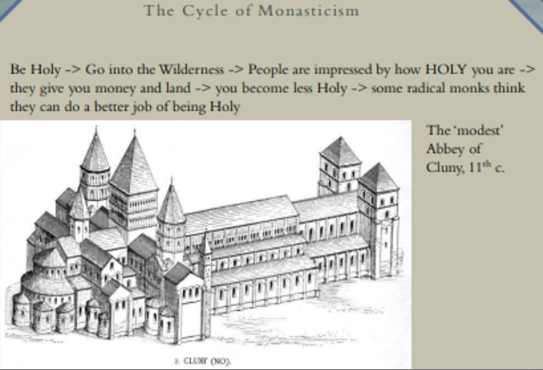
rise Gregorian movem.
What actually happened in this ‘reform Papacy?’
(C12) new monastic orders
(St Francis of Assisi, central Italy, 1209) Franciscans
(1216) Dominicans
Rejected previously established monastic model. Male members a lifestyle of poverty, traveling, and living in urban areas for purposes of preaching, evangelization, and ministry, especially to the poor.
avoid. own. any property @ all
work @ a trade
embraced poor, often itinerant lifestyle
depended for their survival on goodwill people to who they preached
tried to gain living by begging on streets develop. city
believed bad for monastery to be isol ← soc. as had prev. → sent pairs round to talk, heal…
Members these orders monks but friars
Models for relig. life = Desert Fathers, vita apostolica, Benedictine Rule
also concerned to fight heresy, to minister to people in grow. urban environm. + valued learning (also develop. institutionally) (see crusades fcs) (Inquisitions - maybe p.255 Ramirez)
theme: relig. movements
In their rejection papal excess & desire to live in poverty like JC, Franciscans v/sim. to Waldesians (p.225 Femina) → yet 1 most influential monastic movem. within Christinaity, whilst latter excommunicated & driven into hiding.
(institutionalisation) Dominicans & Franciscans authorised by papacy to conduct 1st offic. church inquisitions
rise Gregorian movem.
reforming popes
Leo & Urban both monks ← Cluny - had also been brought up in reform mindset
Greg assoc. with it
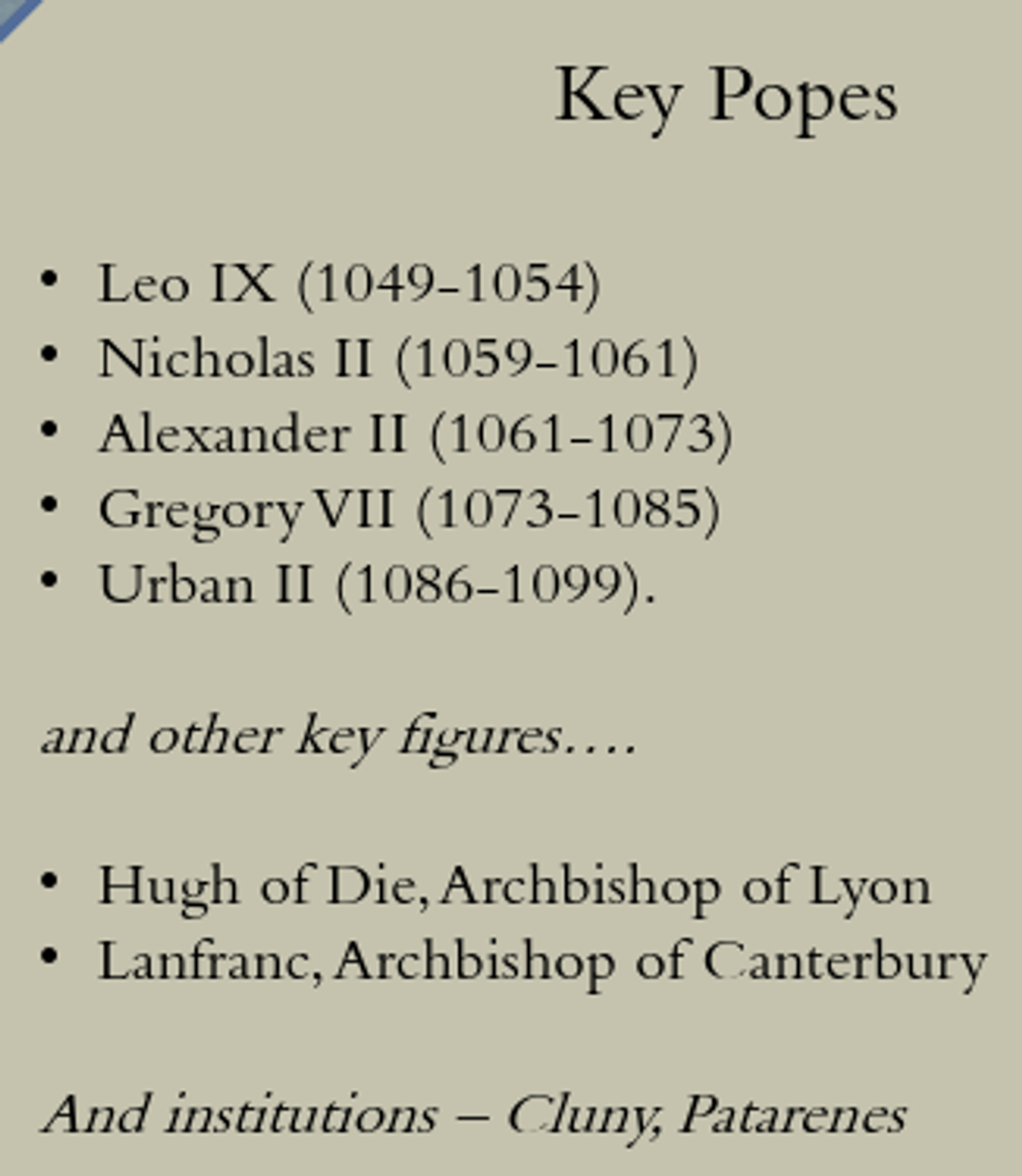
rise Gregorian movem.
What actually happened in this ‘reform Papacy?’
investiture controversy
intensification papal responses to letters - requests urging authorities to stay out of the appointments of bishops + to urge priests who have married/ had sex to be stripped of the title
Reached its peak dur. pontificate Pope Gregory VII & Emperor Henry IV HRE.
Greg | Aim | Method |
|---|---|---|
Reform RCC |
| Issued decrees prohibiting lay investiture (1075 Dictates of the Pope, Dictatus Papae) & simony. Dictatus Papae asserted papal supremacy and control over secular powers. Papacy cannot be subject to secular rule. |
Henry | Aim | Method |
|---|---|---|
Maintain political auth. | Insisted on his right to appoint bishops & abbots within his realm. Resist Greg’s attempt to curtail his influence. | Openly defied Greg’s auth. Continued practice lay investiture. Appointed bishops & abbots within his realm w/o papal approval. |
Conflict escalated into series confrontations bet. 2., includ…
Henry IV’s excommunication
(1076) In response to Henry IV's defiance, Pope Gregory VII issued a papal bull in 1076 known as the "Liber Septimus" or "Book of Seven" in which he excommunicated Henry IV.
The excommunication meant that Henry IV was formally expelled from the Catholic Church and was considered to be outside the communion of the faithful. This had significant political and social repercussions, as it undermined Henry's legitimacy as emperor and could potentially lead to unrest within his realm.
Henry's subsequent penance @ Canossa
In the face of excommunication and the threat of rebellion from his nobles, Henry IV sought reconciliation with the Pope. In January 1077, he traveled to Canossa, where Pope Gregory VII was staying, and famously performed the "Walk to Canossa," a gesture of penance.
Henry's act of submission at Canossa, where he stood barefoot in the snow for three days begging for forgiveness, led to Gregory lifting the excommunication and temporarily resolving the conflict between the emperor and the papacy. However, tensions between secular and ecclesiastical authorities persisted, and the Investiture Controversy continued until its partial resolution with the Concordat of Worms in 1122.
Resolution
Partially resolved w/Concordat of Worms 1122.
Negotiated bet. Pope Calixtus II & Emperor Henry V, Henry IV's son.
Est. compromise:
Secular powers should no longer insist on election of their fav. candidate to office, but that free & fair elections hsould be held by the canons of cathedral/ abbey
alth. this oculd happen in presence secular pwoers & king could still invest bishop w/symobl his secular/ wordly auth.
awkward compromise but est. that lay investiture (as it was called)
longer acceptable
secular rulers retained right to invest bishops w/symbols secular auth. (e.g. ring & staff)
spiritual auth. to appoint bishops remained w/RCC.
Bishops & abbots to be elected by ecclesiastical authorities, & their appointment confirmed by secular rulers.
Signif.
Far-Reaching Implications: The Investiture Controversy went beyond the appointment of bishops and abbots, highlighting tensions between secular and ecclesiastical authorities, struggles for power within medieval society, and broader issues of papal authority and the relationship between church and state.
Struggle for Power: Fundamentally, the Investiture Controversy was a power struggle between the papacy and secular rulers, notably kings and emperors, over authority and sovereignty regarding ecclesiastical matters like the appointment of bishops and abbots.
Separation of Church and State: It contributed to defining the relationship between the Church and the state, raising questions about the roles and jurisdictions of spiritual and temporal authorities, ultimately laying the groundwork for the separation of Church and state in Western societies.
Papal Authority: The controversy strengthened papal authority and independence from secular interference, notably through Pope Gregory VII's efforts to assert the Church's right to appoint bishops, underscoring the papacy's claim to spiritual supremacy and ecclesiastical matters.
Concordat of Worms: The resolution of the Investiture Controversy through the Concordat of Worms in 1122 represented a compromise between the papacy and secular rulers. It granted secular rulers the right to invest bishops with secular symbols of authority while affirming papal authority in spiritual governance.
Impact on Society: The Investiture Controversy had profound consequences for medieval society, leading to political instability, armed conflicts, and shifts in power dynamics across Europe, influencing the political and religious landscape of the medieval world.
rise Gregorian movem.
What actually happened in this ‘reform Papacy?’
banning clerical marriage 1074
see essay for other reasons clerical marriage banned
In 1074, Pope Gregory VII issued a decree explicitly prohibiting clerical marriage. This decree was part of his efforts to enforce celibacy among the clergy and to uphold the Church's moral standards. Gregory's prohibition of clerical marriage was a pivotal moment in the history of the Church and contributed to the establishment of celibacy as a requirement for priests within the Latin Rite of the Catholic Church.
This power struggle underscored the Gregorian movement’s determination in the 11th century to depict the secular world as sinful, necessitating a clear separation to restore the distinction between the secular and ecclesiastical realms.
This separation extended to secular preoccupations with money and attitudes toward sex, allying together the Gregorian revival of the ancient ascetic tradition with the idea of a celibate priesthood to emphasise clerical celibacy and to discourage clerical marriage.[4] This can be seen through Pope Gregory’s equation’s of clerical marriage with evil and uncleanliness in his letter to William the Conqueror concerning Judhael, Bishop of Dol, who by marrying and begetting children ‘so that he had already prostituted his soul [to simony] might likewise dedicate his body in shame to the devil by his lewd and foul lust…’[5] Behind the Gregorian movement's ideals of clerical celibacy, ergo, lay the papacy's paradoxical attempt to maintain authority against the very factors on which it relied for legitimacy. This undermined ecclesiastic lineages and its interactions with the secular realm to make itself seem more holy, thus increasing its authority and power.
rise Gregorian movem.
→ Concordat of Worms affirmed papal monarchy
Combined w/papal sponsoring military activities (e.g. Norman invasion 1066 had papal banners to emphas. its legitimacy)…. transformation papacy
by Innocent III (1198-1216), papacy → political player in its own right.
papacy reached its zenith of control across Europe.
idea papacy = true head Christian community
claimed auth. to regulate daily lives, emphas. church attendance & confession) → papal regulation
even emperors at least acknowl. theoretical superiority pope
Popes 👓n as: over-mighty & grandiose bishops Rome → political players in their own right
🎭 by…
Urban II's Crusades: Urban II continued the agenda, appropriating power for papacy & initiating Crusades.
Church vs. State: Later conflicts saw military engagements between papal and imperial forces.
Papal Monarchy's Peak: Under Innocent III, the papacy reached its height of power, claiming authority over everyday life.
foundations military orders, the persecution of heretics, crusading under papal zeal, developm. fixed system canon law, growth legal institutions & educational institutions like unis
all emblematic of this idea that religion is fundamentally of more importance to Christian commonwealth than secular power
(Laurentius, a canon law jurist ← Spain) early C12
Papal auth.
longer solely dependent on consensus everyone in Europe.Pope's auth. existed independently, deriving its legitimacy ← fullness of power vested in the papal office itself.
In essence, Laurentius pointed out: Pope's authority → inherent to papacy, rather than being contingent upon widespread agreement or acknowledgment from various factions or regions within Europe. This observation reflects a shift in perception regarding the source and nature of papal authority during the medieval period.
Raymond d'Aguilers, chronicler 1st Crusade, depicted papacy's dominance in Latin culture:
Viewed the pope as the ultimate head of Christian Europe by 1100.
🎭 papacy elevated itself over course century ← mere bishops of Rome → dominant figures in Christendom.

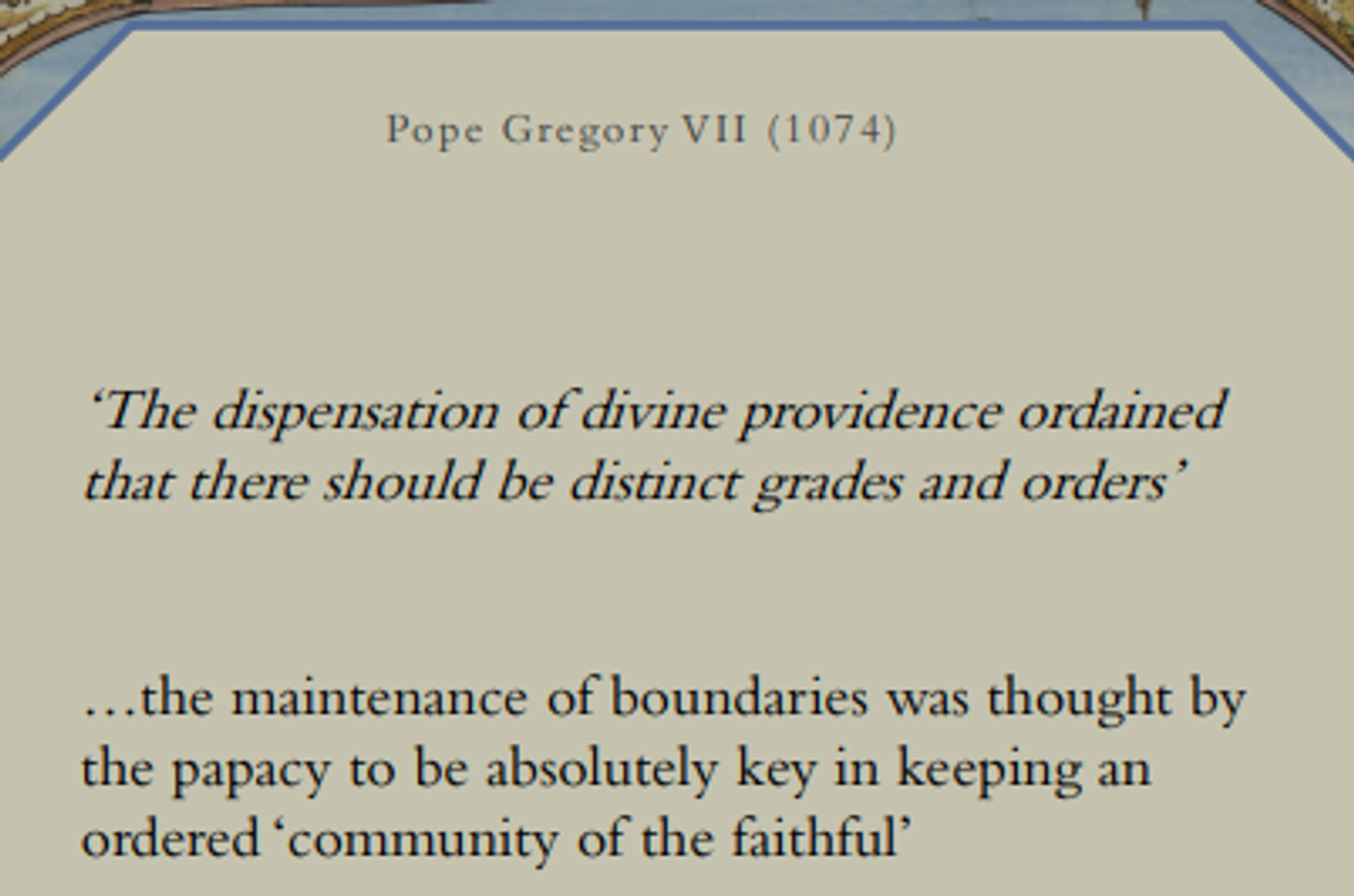
emphasis on sep.
sstructure, community important but anxiety/concern over people breaking these down (strict hierarchy - think fixed price lsit_
partic. shap by en 11th C amongst clergy & Church: should remain diff. monasti corders and thier sort
ecclestiastical world couldn’t be sullied by secular (clerical marriage doesn’t retain purity; neither bishop → king
maintaining boundaries bet. types people thought by papacy and group infuential thinkers 11th & 12th c thought to be absol. key keepng everyth. in soc. running smoothly